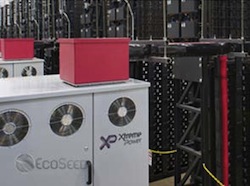Duke Energy Renewables has completed a 36-megawatt (MW) energy storage and power management system at its 153 MW Notrees Windpower Project in West Texas. Development of the storage system began in 2009 with a $22 million grant matching from the Department of Energy and in December the project became fully operational.
“Battery storage is an important innovation to address the variability of wind and solar energy generation,” said Duke Energy Renewables President Greg Wolf. “Developing an expertise in this advanced technology will enable us to expand the use of renewable energy, better integrate it into the power grid and become even more efficient at serving our customers.”
 Austin-based Xtreme Power designed and installed the 36 MW-capacity Dynamic Power Resource at Notrees and will continue to operate the system. The battery storage project will help mitigate the variability of wind power, storing excess wind energy and discharging it whenever demand for electricity is highest. The system will also stabilize the frequency of electricity traveling throughout the power grid. Duke Energy is working closely with Energy Reliability Council of Texas, which signals to the battery storage system to either dispatch stored energy to increase frequency or absorb energy to decrease frequency.
Austin-based Xtreme Power designed and installed the 36 MW-capacity Dynamic Power Resource at Notrees and will continue to operate the system. The battery storage project will help mitigate the variability of wind power, storing excess wind energy and discharging it whenever demand for electricity is highest. The system will also stabilize the frequency of electricity traveling throughout the power grid. Duke Energy is working closely with Energy Reliability Council of Texas, which signals to the battery storage system to either dispatch stored energy to increase frequency or absorb energy to decrease frequency.
“Completion of this project represents a singular success for Duke Energy, for the DOE, and for the entire energy storage community in the U.S.” said Dr. Imre Gyuk, program manager for energy storage at the U.S. Department of Energy. “It will demonstrate the capability of energy storage to mitigate the variability of wind energy and to contribute to the stability of the grid”.
The Electric Power Research Institute will collect performance data from the battery storage system and help assess the potential for broader adoption of energy storage solutions throughout the industry. Technical and economic data will also be analyzed for DOE by Sandia National Laboratory. Results from the storage project at Notrees wind farm will be shared publicly through the DOE’s Smart Grid Information Clearinghouse.

